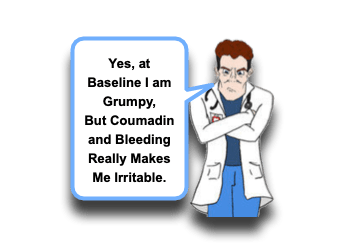Anticoagulation Related Bleeding – Use of Prothrombin Complex Concentrate

Children occasionally deal with “adult” medical problems (ex, Pulmonary Embolism, Cholecystitis, Renal Stones, DVTs) and, hence, may require medications that we don’t typically encounter in the pediatric patient populations. One of my least favorite medications seen on the adult and pediatric medication list is the vitamin K antagonists Coumadin. Yes, it may be needed, but when it causes problems, those problems can be quite critical. Let us take a moment to digest a morsel on oral anticoagulation use in children and means to reverse their effects with Prothrombin Complex Concentrate:
Oral Anticoagulation Use in Children
- Oral Anticoagulant medications are used for a variety of reasons in children.
- Some reasons are similar to adults: [Bonduel, 2006]
- Venous Thromboembolism (DVT, PE)
- Endovascular Stents
- Mechanical Prosthetic Heart Valves
- Atrial Fibrillation
- Arterial Dissection
- Peristent Hypercoagulable States
- Lupus anticoagulant
- Antiphopholipid antibodies
- Central Venous Access Devices (if with prior DVT)
- Children may also be on anticoagulation for unique reasons like, Fontan operation. [Bonduel, 2006]
- Historically, Vitamin K Antagonists like Coumadin (Warfarin) have been used in children (although novel oral anticoagulants are starting to be evaluated as well). [Giglia, 2016; Adam, 2016; Bonduel, 2006]
- Anatagonize clotting factors: II, VII, IX, and X
- Anatagonize Protein C and S as well.
Oral Anticoagulation Reversal
- While anticoagulation is necessary for many conditions, it is not without risk. [Bonduel, 2006]
- Reported risk of Minor Bleeding in children is 1.3 – 2.3% / patient year.
- Reported risk of Major Bleeding in children is 0 – 0.5% / patient year.
- 4-Factor Prothrombin Complex Concentrate (PCC) use in children. [Ashikhmina, 2017; Adam, 2016]
- 4-Factor PCC is just that – it contains the 4 factors that Vitamin K Anatagonists have blocked.
- 4 – Factor PCC contains Factors II, VII, IX, and X… and also Protein C and Protein S. (so… maybe we could call it 4F + 2P PCC).
- In the US, Kcentra is the 4-F PCC that is available, but currently only FDA approved for adults.
- Beriplex and Octaplex exist in other countries for warfarin reversal.
- PCC vs FFP: [Ashikhmina, 2017]
- PCC is universally compatible and can be stored at room temperature.
- Can be delivered more rapidly without ABO typing.
- PCC dose is delivered in a smaller volume compared to FFP (which may be advantages in small children with cardiac conditions).
- PCC is less immunogenic compared to FFP.
- PCC will not alter Calcium levels.
- PCC may be associated with greater risk for subsequent thrombosis, however (based on older data).
- Still, research is overall lacking on defining appropriate indications of use, exact dosing, and variances with age populations.
- PCC is universally compatible and can be stored at room temperature.
- PCC is contraindicated in the setting of Disseminated Intravascular Coagulation [Ashikhmina, 2017]
- Management of supra-therapeutic coumadin is based on symptoms and severity. [Karube, 2020; Ashikhmina, 2017; Giglia, 2016; Adam, 2016; Bonduel, 2006]
- Currently, there are no clearly defined guidelines for children.
- Stopping the Coumadin is obviously a good first step, but it has a long half-life, so reversal will likely be needed if the patient is symptomatic or has at risk of morbidity or mortality. [Giglia, 2016]
- If bleeding is NOT life threatening / associated with morbidity, then consider:
- Risk of reversal
- Ex, Vitamin K may need to be avoided if anticoagulation is required for mechanical prosthetic valves or Fontan.
- Best to discuss with specialist managing that condition.
- Vitamin K (Oral, Sub Q, or IV) and/or
- FFP 20 ml/kg
- Risk of reversal
- If bleeding is LIFE THREATENING/ Associated with Morbidity, then consider:
- Vitamin K (5 mg IV) and
- FFP 20 ml/kg or
- Prothrombin Complex Concentrate [Karube, 2020; Guzzetta, 2017; Ashikhmina, 2017]
- Dosing for patients < 18 years of age is not established.
- 25 Units/kg IV rounded to nearest vial size has been reported. [Adam, 2016]
- Recommend discussing with Pharmacist and Hematologist.
- May need to adjust based on INR level as well.
- For adults, dosing is based on INR level:
- INR 2-3.9; dose = 25 Units/kg IV x1 (max = 2500 Units)
- INR 4-6; dose = 35 Units/kg IV x1 (max = 3500 Units)
- INR >6; dose = 50 Units/kg IV x1 (max = 5000 Units)
- Dosing for patients < 18 years of age is not established.
Moral of the Morsel
- Some kids just wanna be like adults! It be may uncommon for a child to be on anticoagulants, but when they are, they can have adult style complications too.
- Consider the ramifications of reversal. Vitamin K may not be the best answer in the child with a new mechanical valve. Speak with their specialist.
- PCC sounds cool… but it may be too early to use it universally. Know of the advantages of PCC and keep PCC in your toolkit, but realize experience with them in children is still limited.

